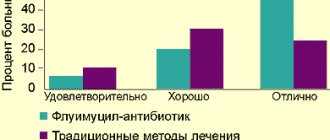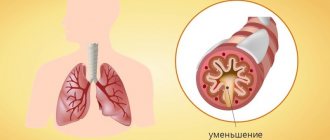How to recognize acute bronchitis
The main symptom of acute bronchitis in adults is a cough, which occurs as a response of the body to an irritant and a desire to restore patency of the airways. On average, it lasts 2-3 weeks, accompanied by other signs of colds. Cough with bronchitis changes its character over time. At first it is dry, intrusive, sometimes even annoying, debilitating. As the disease progresses, it gradually becomes wet (productive). At this moment, a protective mechanism is launched: the cells of the bronchial mucosa begin to actively produce sputum, and with it, during a wet cough, various pathogenic agents, primarily viruses and bacteria, are removed from the body. The color and consistency of sputum, among other things, can tell the doctor the cause of the disease and, therefore, the optimal treatment regimen.
In addition to coughing, bronchitis may be accompanied by symptoms such as:
- weakness, feeling of weakness, fatigue;
- increased body temperature;
- runny nose;
- sweating;
- headache;
- chest pain;
- shortness of breath (in severe cases of the disease).
The symptoms of acute bronchitis in children are the same as in adults, but may be more pronounced.
Bronchitis: development factors, symptoms, treatment
Bronchitis
is an inflammatory disease that affects the mucous membrane of the lungs and bronchial tree. Inflammation is usually caused by viruses (the same ones that cause acute respiratory infections, influenza) or a secondary bacterial infection (infectious bronchitis). However, bronchitis can also occur from inhaling substances that irritate the lungs, such as various toxic chemicals, dust, ammonia (used in various cleaning products), and smoke. People with other lung diseases, such as asthma, may get bronchitis frequently, as can people with chronic sinusitis. Bronchitis is usually mild and often does not cause long-term disability, but in older people, smokers, or patients suffering from chronic heart and lung diseases, it can become a serious problem.
The main factors for the development of bronchitis:
• physical factors (damp, cold air, sudden temperature changes, exposure to radiation, dust, smoke); • chemical factors (presence of pollutants in the atmospheric air - carbon monoxide, hydrogen sulfide, ammonia, chlorine vapor, acids and alkalis, tobacco smoke, etc.); • bad habits (smoking, alcohol abuse); • stagnant processes in the pulmonary circulation (cardiovascular pathologies, disruption of the mucociliary clearance mechanism); • the presence of foci of chronic infection in the oral and nasal cavity - sinusitis, tonsillitis, adenoiditis; • hereditary factor (allergic predisposition, congenital disorders of the bronchopulmonary system).
Bronchitis comes in two types: acute and chronic.
Symptoms of acute bronchitis.
Infectious bronchitis usually occurs during the cold season. As a rule, it begins with symptoms reminiscent of a common cold, first of all, fatigue, a sore throat, then a cough. At the onset of the disease, the cough is often dry, but later it becomes wet (productive) with the separation of mucous or purulent sputum. In more serious cases, a rise in temperature may occur. If your symptoms persist or worsen, your doctor may send you for a chest X-ray to make sure there is no pneumonia (pneumonia), which can be a serious complication of bronchitis.
Symptoms of chronic bronchitis.
The term “chronic bronchitis,” in contrast to acute bronchitis, is used by doctors to designate a long-term disease that does not go away for three or more months. Cough and sputum production may recur annually and last longer each time. Chronic bronchitis often occurs with prolonged inhalation of various irritating substances, such as cigarette smoke and harmful environmental factors.
The main difference between the processes in the lungs during acute and chronic bronchitis is that with chronic bronchitis, the bronchial mucosa produces more mucus, which causes a cough, while with infectious bronchitis, the cough occurs mainly due to inflammation of the respiratory tract. One of the most common causes of chronic bronchitis is constant smoking.
Bronchitis is a fairly serious disease. Only a doctor can correctly diagnose and prescribe therapy. If your cough produces yellow or greenish sputum or your body temperature is very high and does not decrease for a long time, then it is likely bacterial bronchitis. In this case, your doctor may prescribe antibiotics to help fight the infection.
The pharmaceutical company "Minskintercaps", taking care of your health, produces the drug "Evkamint" for the treatment of diseases of the upper respiratory tract. The drug contains substances of plant origin - eucalyptus oil and peppermint oil. Eucalyptus oil is traditionally used to relieve cold and cough symptoms. Peppermint oil enhances the effect of eucalyptus oil, relieves pain and spasms of the gastrointestinal tract.
In what cases is Eucamint indicated?
"Evkamint" is used in the complex treatment of inflammatory diseases of the upper respiratory tract: - acute and chronic bronchitis; - sinusitis; - tracheitis; - pharyngitis.
How to take "Evkamint"?
Adults and children over 12 years of age take “Evkamint” orally, 1 capsule 4-5 times a day. Capsules should be taken before meals. It is not recommended to bite or chew Evkamint capsules in the mouth to prevent the premature release of peppermint oil, which can have a local irritant effect on the mucous membrane of the oral cavity and esophagus.
Raw materials for the production of "Evkamint" are purchased in France. The medicine has contraindications and side effects. Contraindicated during pregnancy. Before using the medicine, read the instructions.
For twenty years, Minskintercaps has been purposefully working to provide patients with effective, high-quality and affordable medicines.
THE MAIN PRIORITY OF MINSKINTERCAPS IS HUMAN HEALTH!
16 Feb 2017
Previous News Feed Next
Causes of acute bronchitis
The cause of acute bronchitis in adults in the vast majority of cases is an infection: most often viral, less often bacterial, and occasionally fungal. In addition, the disease can be of an allergic nature (due to a high concentration of allergen in the air), develop in the presence of inflammation of the adenoids or chronic foci of infection in the paranasal sinuses, against the background of tonsillitis.
It is worth considering factors that reduce local immunity and contribute to the occurrence of the disease:
- hypothermia;
- smoking;
- alcohol abuse;
- hereditary diseases;
- chronic pathology of the nasopharynx;
- unfavorable climate (dampness, cold);
- air polluted with dust or toxic impurities.
Types of acute bronchitis
Depending on the nature of the inflammation, acute bronchitis can be:
- catarrhal (accompanied by an increased amount of bronchial mucus);
- fibrinous (with the formation of thick, sticky and difficult to separate sputum);
- mucopurulent/purulent (with copious amounts of mucus and discharge of pus);
- hemorrhagic (with streaks of blood in the sputum due to hemorrhages in the bronchial mucosa in severe forms of the disease).
According to the prevalence of the inflammatory process, acute bronchitis in adults is usually divided into focal, in which inflammation is localized in a limited area of the bronchi, and diffuse, covering most of the bronchial tree.
How to treat acute bronchitis
When the first signs of the disease appear (if no more than 48 hours have passed since its onset), antiviral drugs may be prescribed. Treatment of acute bronchitis with antibiotics is usually not practiced. It can be justified only if whooping cough is suspected and bacterial complications are confirmed. How to treat acute bronchitis in the presence of an intense cough? In this situation, to reduce the risk of side effects, the mechanism of action of the drug and the presence of contraindications should be taken into account. For a dry hacking cough, antitussives can be used. When coughing is accompanied by the discharge of viscous sputum, mucolytics are prescribed to improve the discharge of mucus from the respiratory tract. You can rely on herbal preparations, such as cough medicines Doctor MOM®.
There are also general recommendations that are relevant for the treatment of acute bronchitis of any nature:
- compliance with bed or semi-bed rest (depending on the patient’s condition);
- consumption of large amounts of warm fortified liquid (up to 2–2.5 liters per day). However, you should avoid drinks containing caffeine and alcohol, as they dehydrate the body and worsen inflammation. Decoctions of rose hips, raspberries and linden blossoms, fruit drinks and heated mineral water will bring benefits;
- to give up smoking;
- protecting the patient from irritating factors: dust, smoke, strong odors and toxic fumes;
- regular ventilation of the room and maintaining an optimal level of humidity in it (50-70%). To humidify the air, you can use both special climate control devices and improvised means, for example, a wet towel hung on a radiator.
In acute bronchitis, mucolytic agents are used to treat cough and facilitate mucus discharge, which thin the mucus and facilitate its removal. For example, you can use Doctor MOM® herbal cough syrup, which contains extracts of 10 medicinal herbs and has a complex effect: secretolytic (increases the secretion of protective mucus), mucolytic (reduces the viscosity of sputum), expectorant (removes phlegm), bronchodilator (relaxes the bronchi) and anti-inflammatory . The syrup is suitable for adults and children over 3 years of age. Ignoring the symptoms and inadequate treatment of acute bronchitis in adults can lead to the disease becoming chronic and the development of very serious complications.
Purulent bronchitis
Bronchitis is inflammation of the bronchial mucosa. In advanced cases, the bronchial tree is affected, and the patient experiences copious discharge of purulent mucus.
What is purulent bronchitis?
Purulent bronchitis is a type of disease that poses a serious threat to life. When the immune system is weakened, bacteria penetrate the body and, by multiplying, provoke the rapid spread of the pathological process.
In advanced cases, the disease becomes chronic. In this case, the patient systematically experiences relapses - 2-3 times a year.
Kinds
Purulent bronchitis is considered a type of acute or chronic. Characterized by coughing up sputum containing pus.
In medicine, catarrhal and purulent bronchitis are distinguished; hemorrhagic and fibrinous are less common. Purulent bronchitis can be an independent or secondary disease that develops against the background of concomitant inflammation.
Causes
The reasons for the development of the disease can be external and internal. In the first case, purulent bronchitis can be provoked by weakened immunity, smoking, systematic hypothermia, and frequent infectious lesions of the respiratory system. In the second - sinusitis, chronic tonsillitis or pneumonia, tuberculosis, tracheitis, acute bronchitis, ARVI.
Provoking factors:
smoking;- obesity;
- age-related changes;
- alcohol abuse;
- side effects of taking medications;
- heredity;
- adverse environmental impacts;
- lack of vitamins.
Symptoms and signs
Purulent bronchitis usually develops against the background of a cold, hypothermia, allergies, stress, activation of a chronic source of infection, etc. The main symptoms include severe intoxication, cough and shortness of breath.
In the acute period, low-grade fever, general weakness, profuse sweating, cough with the discharge of thick greenish-yellow sputum with an unpleasant odor are observed. If the process is chronic, purulent sputum is present constantly or occasionally (during periods of exacerbation). Some patients complain of hemoptysis. This is explained by the increased vulnerability of the bronchial mucosa.
Which doctor treats you?
A pulmonologist treats purulent bronchitis. By contacting our clinic, you can check your lungs and, if necessary, other organs. Our staff consists of only experienced specialists. The patient, without leaving the clinic, can undergo a complete diagnosis, visit specialist doctors and immediately begin treatment.
Diagnostic methods
The modern equipment of our clinic allows us to detect any disease at an early stage. Diagnosis of purulent bronchitis requires a careful approach. It is important to differentiate the pathology from other diseases with similar symptoms.
First, the doctor conducts a primary examination and studies the patient’s medical history. Having made a preliminary diagnosis, the pulmonologist prescribes a number of instrumental and laboratory tests:
- general and biochemical blood test;
- microscopy;
- sputum analysis;
- bronchoscopic examination;
- CT scan of the chest;
- spirometry.
If necessary, other types of studies may be prescribed.
Treatment methods
Purulent bronchitis develops due to the proliferation of pathogenic microorganisms. Folk remedies in this case are ineffective.
Antibiotics are prescribed first. If the disease was preceded by an acute respiratory viral infection, antiviral drugs are indicated. Mucolytics are prescribed to liquefy and remove sputum.
In addition to drugs for the treatment of purulent bronchitis, the following drugs can be used:
- Bronchodilators - reduce swelling and normalize breathing.
- Antihistamines - reduce sensitivity to allergens and the negative effects of other medications.
- NSAIDs relieve pain and reduce fever.
- Immunomodulators and vitamins.
Additionally, physiotherapy is prescribed - UHF, magnetic therapy, electrophoresis.
results
The prognosis for treatment of purulent bronchitis is relatively favorable. Loss of ability to work occurs only during periods of exacerbation. However, chronicity of the process significantly reduces the quality of life and can cause the development of pneumonia, respiratory failure, emphysema, and pulmonary hypertension.
Rehabilitation and lifestyle restoration
Prevention of purulent bronchitis implies compliance with the following rules:
- to give up smoking;
- improvement of working conditions;
- change of place of residence due to unfavorable environmental conditions;
- seasonal flu vaccination;
- timely treatment of infectious diseases of the ENT organs.
To prevent exacerbations, you should regularly visit a pulmonologist.
Lifestyle with purulent bronchitis
First of all, you should strengthen your immune system, give up bad habits, and normalize physical activity. In summer, vacations at resorts are shown.
If you are unable to protect yourself from the disease, it is important to consult a doctor in time and follow all his prescriptions without giving up treatment. This will significantly increase the likelihood that bronchitis will pass without irreversible consequences for the body.
| Name of service | Price in rubles | Price until 19.12. |
| CT scan of the chest in the morning and evening hours. Promotion | 4 990 | 2 900 |
| CT scan of the chest | 4 990 | 2 790 |
If you do not find a service in the price list, please call us and we will provide you with the necessary information.
Our doctors will help you:
General practitioner, immunologist
Zhemchugov Vladislav Evgenievich







